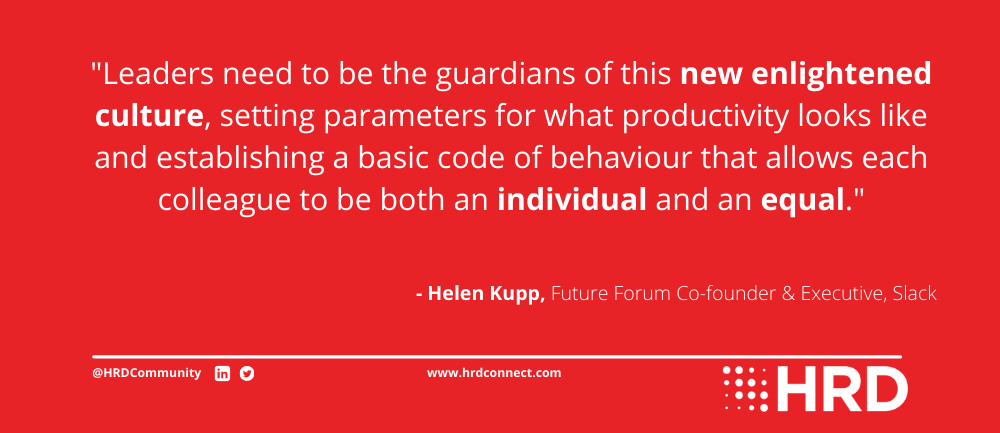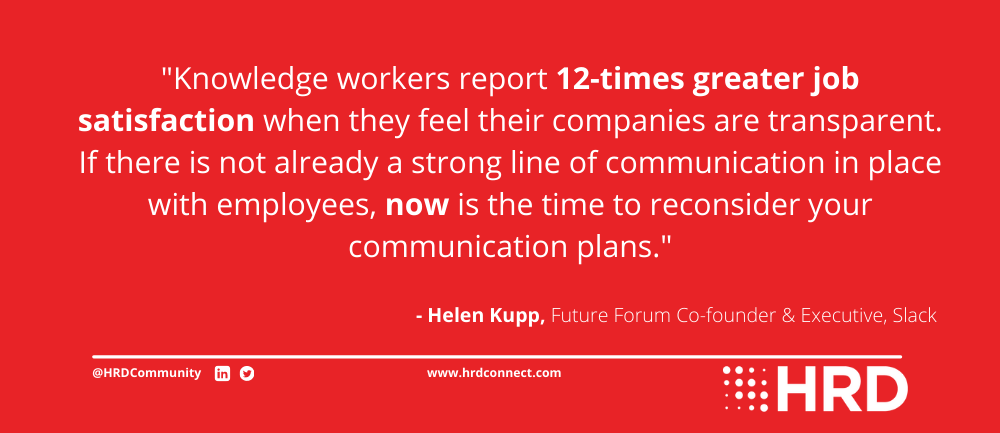-
Provided by

- Date published: Sep 20, 2022
- Categories
Earlier this month, a group of Apple employees rose up in protest against a communique from CEO Tim Cook, ordering them to return to the office. The group, calling themselves Apple Together, said they have proven themselves able to work remotely during the pandemic and see no reason to change.
Nothing new in this, you might think. We know that millions of people value the freedoms they adopted during Covid-19, and believe they proved themselves able to handle the responsibility during a period of great adversity and stress.
But actually, what’s interesting about the Apple bite-back is that Cook wasn’t telling his troops to return to the office full-time (as others like Elon Musk have done). Rather, he was asking them to return only three days a week, a compromise which would have seemed hugely progressive as recently as 2019.
Now, however, employees don’t just want remote working: they want the freedom to determine their own work schedules. The Apple petitioners are demanding that they be allowed to decide their own working arrangements in tandem with their “immediate manager”, and that they should not be subject to “high-level approvals” and “complex procedures” or have to provide private information.
This is the ‘2.0’ of the remote age. Employees are determining the freedom to, effectively, determine their work location. In other words, they want flexibility in its truest sense.
For HR leaders, this poses unique challenges. We have to create an environment that is at once fair and bespoke; an environment that bends and flexes to each individual colleague without losing our collective purpose or code of values.
____
Helen Kupp is co-founder of Slack’s Future Forum and co-author of the best-selling ‘How the Future Works’. Here she tells HRD Connect what the new, flexible age means for our leaders, and how we can help them bridge the skills divide.
Some readers will feel daunted by this conundrum. But according to Helen Kupp, we have no choice but to lean into the skid.
“Instead of reverting to a particular way of working because that’s how it has always been done, we need to look towards enabling employees with greater autonomy around how they work if they want to attract and retain the best people.
“There isn’t a one-size-fits-all approach to flexible work and we’ll continue to see new challenges that require experimentation. To future-proof our organizations, we need to normalize a culture of learning and get comfortable with confronting change.”
____

‘People want a say – taskforces are a great way forward’
Helen, who graduated from Harvard Business School and previously worked for Bain and Company, can speak from a wealth of experience.
At Slack, she has helped support the growth of one of the world’s most popular distance work tools, especially for distributed teams. Slack’s business communication platform is now fundamental to both remote and flexible working, and the company has sought to role-model this new paradigm by creating a progressive blueprint for its own staff. Beyond a quorum of ‘core collaboration hours’ during which teams are expected to work in sync, each individual teammate is free to set their own schedule.
In an effort to spread the gospel of flexible working, Helen has played a key role in the creation of Slack’s Future Forum, which continues to mine a rich seam of data about what today’s employee wants. Indeed, she points to research from Future Forum’s latest pulse survey which shows that the desire for flexible work is now greater than ever; only 20% of knowledge workers now want to be in the office full-time, the lowest percentage in two years of surveying.
What’s more, Future Forum’s research shows that 70% of workers are open to looking for a new role if they don’t get the flexibility that they’re looking for. This threat is compounded by the emerging trend of ‘quiet quitting’, a feeling of disengagement which means workers refuse to work extra hours, withdraw from the team and even bad-mouth their employer on social media.
To head off these pitfalls, Helen believes it’s vital that we listen to our people. “The reality is that top down mandates don’t work,” she says. “People want a say in how flexible work will be enabled.”
To build this listening culture, HR leaders should consider “forming a task force made up of executives and employees from different backgrounds who can offer perspectives, test new theories, share best practices, and help shape the path forward.
“Creating a culture that encourages experimentation, whether in where or when we work or in how we achieve goals as an organisation, allows us to keep evolving as businesses grow and change.”

____
None of this is to say that the role of the leaders has become less important. Far from it: in fact, leaders need to be the guardians of this new enlightened culture, setting parameters for what productivity looks like and establishing a basic code of behaviour that allows each colleague to be both an individual and an equal.
“Rather than rely on top-down mandates, leaders can establish principles and guardrails that define what flexible work means to the organisation,” Helen says.
“Principles ground the approach on core company values while guardrails guide behaviour. This dual approach gives people structure to get started, but leaves room for teams to test and learn.
“Similarly, it’s important to encourage teams to be intentional about redesigning the way they work together within the structure of those organisational principles and guardrails by using tools like team-level agreements to codify working norms. These agreements help set expectations for how team members will work together, including standards that govern your team’s daily work or when and why you meet in person.”
This constitutes a fundamental shift in the nature of leadership, to be sure. We’re no longer gatekeepers, but empathetic coaches; as Helen notes, it’s now about soft skills, the ability to make behavioural ideals actionable and connect the right people to the right opportunities.
“Rather than continue to rely on tactics like task-tracking or online-status monitoring that aren’t grounded in trusting your team, we have to reskill our managers to do three things: inspire trust, create clarity, and unlock potential in their people.”
‘We need to help managers open discussions with their teams’
If we want to bridge this gap, we’ve got an awful lot of work to do.
All the current evidence suggests leaders lack the skills they need for the new reality. In July, a study by leadership development firm AceUp revealed that nearly three-quarters of employees find their bosses uninspiring. Meanwhile, a poll by U.S. collaborative skills platform 360Learning suggests that over half of all leaders and managers believe they have received inadequate training to handle issues such as workplace stress.
To start making up ground, Helen says we need to clearly redefine the role of managers, noting their new role as coaches, “and support them in this new role through the use of training and tools/templates that can be easily leveraged to start open discussion with their teams.
“For example, as managers learn to build trust in their teams, we often recommend developing a Personal User Manual (PUM), a one-page document outlining preferences on how a person works—their working style, their goals, communication style, what people get wrong about them and ways to help them grow.
“Managers can create this to more transparently communicate their communication preferences and developmental areas. But they can and should also encourage the rest of the team to create PUMs of their own to share more broadly.
“Every person has their own communication style: different ways they ‘intake’ information, feedback, or requests. Being explicit and up front about what works best for each individual can help teams navigate varying communication styles and reduce misunderstandings.
“More importantly, we’ve seen successful leaders use PUMs to start richer dialogue about team dynamics (especially when under tight deadlines or stressful situations) and create deeper relationships and trust across the team.”

____
‘We can separate leadership from management’
At the same time, we can of course turn to the market. In the brave new world of distance work, our talent pool now covers the entire planet, so it’s easier than ever (in theory) to find the right people.
Indeed, we can use our recruitment operation to shift the entire narrative around our organisation. Helen even recommends hiring executives and senior leaders from more distributed locations and time zones, to remove the idea of a “C-suite floor at headquarters.”
However, the remote age isn’t just creating more choice for us; it’s creating more choice for our potential hires, too. With so many vacancies out there, the need to stick in jobs and prove one’s reliability has evaporated. As a result, the number of new hires quitting within their first 30 days is reaching all-time highs.
Which means that recruitment is an increasingly risky business. And not only that, it carries less cultural weight than internal development, which provides an opportunity to strengthen our employee brand and share our mission among our people.
As Helen puts it, “we have an opportunity to redesign career tracks and separate ‘leadership’ from ‘management.’ Too often, the only way for people to advance in their careers is by becoming a manager, which results in a large cohort of middle managers who have no real desire to lead.
“Instead, organisations can create multiple career tracks for people to advance: a management track and a non-management one, and continue to support growth along both paths.”

To complement and reinforce this approach to internal development, we need to focus time and resources on communicating with our people, emphasising our new approach to leadership and progression.
Indeed, Helen says that corporate communication is now more important than ever. “Amid the Great Resignation, employees are holding leadership more accountable and expect more transparency on flexible work plans. Employees who don’t feel their company is being very transparent regarding post-pandemic remote working policies are 3.4 times more likely to look for a new position in the coming year.
“That’s because it comes back to trust in your people and communicating not just the ‘way of’ but the ‘why and how of’ flexible work at your organisation. Our data shows knowledge workers report 12-times greater job satisfaction when they feel their companies are transparent. If there is not already a strong line of communication in place with employees, now is the time to reconsider your communication plans.”
In fact, if we truly want to create effective leadership for the flexible world, we need to reconsider a whole range of things: how we train, who we train, what we want to build and how we want to prioritise it.
It won’t be easy. In fact, as Helen says, it is going to require “almost continuous investment”. But, she adds, the benefits are clear.
If we can improve the quality of our coaching and feedback, and find ways to celebrate great management, “we not only increase the support and training that our leaders receive, but we create an ongoing feedback loop where leaders can better learn from each other and their ongoing experiences.
“The reality is, the job of the manager has fundamentally shifted (even before the pandemic!) and soft skills matter more than ever. Rather than continue to rely on tactics like task-tracking or online-status monitoring that aren’t grounded in trusting your team, we have to reskill our managers to do three things: inspire trust, create clarity, and unlock potential in their people.
“Managers need to shift from gate-keeping to coaching with empathy. Not only is this how we ensure that we don’t repeat those mistakes of the past (presenteeism, punch-clock mentality), but it is how we unlock our organisation’s unique potential to create more engaged, diverse teams that are more innovative and successful in the long run.”







